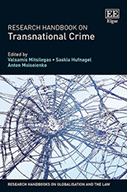Research Handbook On Transnational Crime

Editors: Valsamis Mitsilegas; Saskia Hufnagel; Anton Moiseienko
Publisher: Cheltenham, UK: Edward Elgar Publishing Limited, 2019. 544p.
Reviewer: Yuliya Zabyelina | May 2021
Policymakers, law enforcement, and scholars have long observed the growing diversity and sophistication of criminal actors and illicit activities which may be categorized as “transnational crime.” The editors of The Research Handbook on Transnational Crime, namely Valsamis Mitsilegas, Saskia Hufnagel, and Anton Moiseienko, offer to explore transnational crime in the larger context embracing individual cross-border crimes and varied geographical locations. The authors of this book have done an outstanding service to the body of knowledge on the topic by bringing together in one volume so many diverse viewpoints and interdisciplinary perspectives. This volume’s comprehensive coverage of transnational crime and subtlety of interpretation of multifaceted aspects of the international regime against it will surely benefit future cohorts of scholars and practitioners.
The book offers a detailed and comprehensive account on transnational crime, covering a number of its major types, including terrorism, money laundering, environmental crime, migration-related crime, human trafficking, drug trafficking, cybercrime, and heritage crime. Each of these crimes is addressed in three separate chapters: first written from a legal perspective, second through the prism of criminology, and third focusing on matters of policing and prosecution. The legal perspective pertains to the legal standards that have been adopted to combat transnational crime globally, in select regions, and in domestic laws. Social and cultural dimensions of transnational crime, which raise important questions of implementation of laws on the ground and shed light on different aspects of criminal justice institutions, operations of criminal groups, and harms caused to victims, are discussed in the chapters written from the criminological perspective. In the chapters on policing and prosecution, authors describe the status quo of law enforcement and prosecutorial powers that counteract transnational crime and bring perpetrators to justice.
The book is divided into three sections, each dedicated to specific aspects of transnational crime. The first section, entitled General Observations on Transnational Crime, introduces the reader to legal responses to transnational crime through a global perspective (Chapter 2), defines what transnational crime is from the criminological point of view (Chapter 3), and expands on existing policing and prosecution efforts against transnational crime (Chapter 4). Following these rather general chapters dedicated to the holistic understanding of transnational crime, the subsequent section on Types of Transnational Crime elucidate trends and patterns in relation to the eight crimes identified as “transnational crime.” This is the longest section in the volume that consists of 24 chapters. The final section of the book is Transnational Crimes in Regional Perspectives. In this section authors reinforce the importance of local factors and regional legal and institutional mechanisms that have an impact on trends and patterns of transnational crime. The six chapters of this section cover the European Union, the Meuse-Rhine Euroregion, ex-Soviet countries, Asia, the African Union, and South America. They bring in unique regional aspects of transnational crime from different parts of the world, emphasizing the complexity of this form of deviance and its varied manifestations across countries.
While acknowledging the book’s considerable contribution to the body of knowledge on transnational crime, its deficiencies mostly relate to its overall Eurocentric concentration. Although the book discusses the milestones of the international regime against transnational crime and covers some of the deep-seated problems from the world’s regions, most chapters place an emphasis on European experiences and European societies.
Altogether, the clearly structured narration, well-explained concepts, and landmark cases presented in a straightforward language, combined with an up-to-date interdisciplinary view of the challenges and risks posed by transnational crime, make this book indispensable for undergraduate and graduate students in courses on international criminal justice, contemporary issues of global security, and transnational security threats. The volume combines breadth with depth, enabling students to understand vital aspects of what constitutes transnational crime and the counteracting measures against it today
Yuliya Zabyelina, PhD, Associate Professor of International Criminal Justice, John Jay College of Criminal Justice, City University of New York (CUNY).


